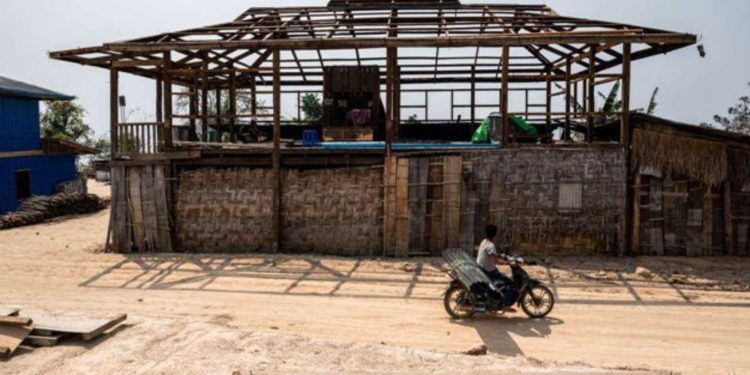Yet another military slaughter claims 29 civilians, including three monks, according to the National Unity Government
In this photo taken on March 9, a villager rides past a house damaged following air strikes by Myanmar’s military at Kone Tar Village, Namhsan Township in Myanmar’s northern Shan State. (Photo: AFP)
Another massacre in Myanmar — the fourth this month — was designed by the military to ignite a religious conflict, the National Unity Government (NUG) said March 16 after releasing the grisly details of the killings of 29 civilians including three monks.
It said claims by the junta that those killed were justified as they were members of the NUG’s armed wing, the People’s Defense Force (PDF), were wrong and trumped up in a bid to turn the Buddhist clergy against those opposed to the military takeover two years ago.
Twenty-nine civilians were massacred at Nam Nein Village in Pinlong Township, Shan State near its southern border with Karenni State on March 11. Of them, 22 bodies were recovered the following day and funerals were held on March 13. Another seven dead were identified by PDF drones.
Junta spokesman Maj. Gen. Zaw Min Tunn had previously claimed on Myanmar radio and television that the Karen National Progressive Party and Karenni National Defense Force (KDF) had conducted the killings and blamed their deaths on junta troops.
“Many of the bodies had signs of torture”
The junta also claimed that those killed belonged to the PDF but the NUG said the military was trying to “shift the blame” and “create problems between different ethnic and religious groups and start a religious conflict.”
Bo Bo, the deputy township police chief of the Karenni State Police (KSP), said 5.51mm bullets fabricated in 2022 had been fired from automatic rifles during the slaughter and added “this type of bullet is only used by the military.”
The military “had killed the monks and requested the KSP to investigate. We checked the deceased, the bodies, and for torture” at the nearby Dragon Hill Pagoda, he said.
A coroner and medical officer, who declined to be named, with Karenni State, told the press conference that many of the bodies had signs of torture including broken legs, beatings and burns, and had “been shot at very, very close range.”
“Bodies had also been slashed after they were shot to make sure they were dead,” he said, “including old villagers, they were killed by the military and tortured by the military.”
“Ten were taken to one side and killed. The others heard the shots and must have been asking themselves, ‘when will it be my turn’,” he said. “People were in great suffering before they were killed … this is a serious inhumane war crime.”
“These were systematic killings”
NUG Human Rights Minister, Aung Myo Min, said the slaughter at Nam Nein was the fourth mass killing in Myanmar this month.
He said “these were systematic killings, actions that constitute war crimes,” which will be raised with the Association of Southeast Asian Nations, the International Criminal Court (ICC) and the UN Security Council.
Last week the NUG asked the ICC to expand its current investigation into the slaughter of the Rohingya along the Bangladesh border area to cover Myanmar’s territory, which it said would be consistent with the NUG’s declaration under the Rome Statute.
That came after it had held a press conference where victims testified to massacres inflicted in Tadaing village, a cluster of about 80 homes, between Feb. 28 and March 2 in the Sagaing region of northern Myanmar.
The massacres were allegedly committed by the Myanmar military’s Light Infantry Division (LID) 99 — also known as the ‘Ogre Column.’ Combined with other reports, the NUG said that at least 37 people were tortured, mutilated, and killed by junta personnel over three days.
Latest News
Credit: Source link




